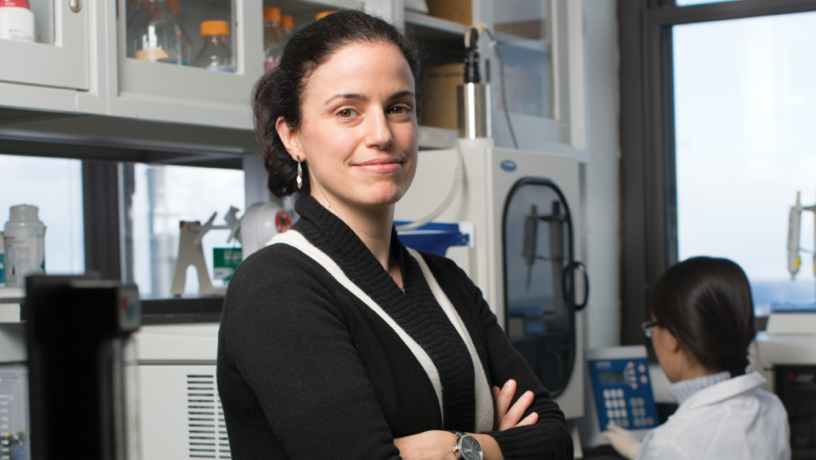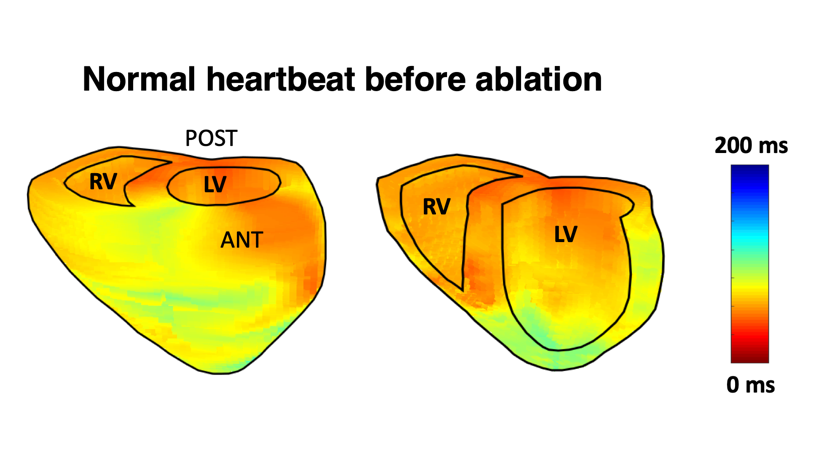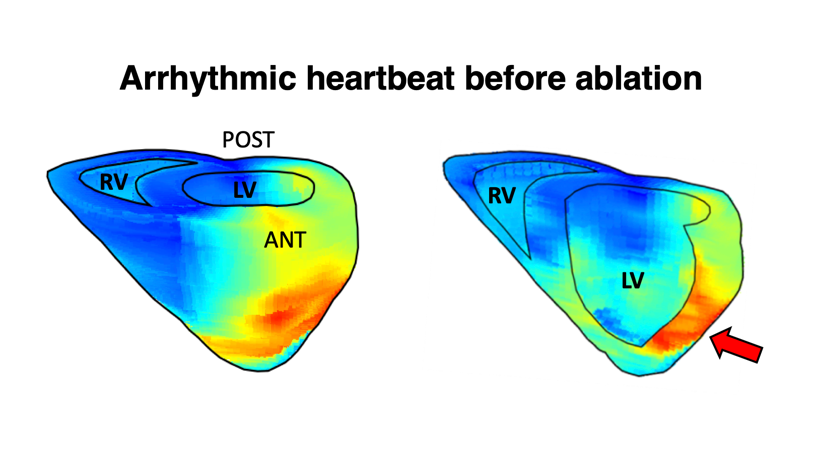Elisa Konofagou Elected to the National Academy of Medicine
Biomedical engineer honored for her leadership and innovation in ultrasound imaging and therapeutics in medical practice and treatment

Elisa Konofagou, Robert and Margaret Hariri Professor of Biomedical Engineering and Professor of Radiology
Elisa Konofagou, the Robert and Margaret Hariri Professor of Biomedical Engineering and Professor of Radiology at Columbia University, has been elected a member of the National Academy of Medicine (NAM), one of the highest honors in the fields of health and medicine. Election to the Academy recognizes individuals who have demonstrated outstanding professional achievement and commitment to service. The NAM cited Elisa’s “leadership and innovation in ultrasound and other advanced imaging modalities and their application in the clinical management of significant health care problems such as cardiovascular diseases, neurodegenerative diseases, and cancer, through licensing to the major imaging companies.”
“I am delighted and humbled after receiving this wonderful news! Thank you to the NIH for your support,” says Konofagou. “I owe this tremendous honor to all the extremely talented students, postdoctoral fellows and staff that have come through my lab over the years. I also owe this recognition to my colleagues and collaborators, both at Columbia Engineering and Columbia University Irving Medical Center. It has been an absolute privilege and honor to work on important clinical problems that we as engineers could help solve, but also benefit from the clinical perspective on what a patient may need for a more accurate diagnosis, targeted treatment, or better quality of life. I am also indebted to the patients in our studies for their time to allow us to develop and test our technologies.”
Konofagou continues, “I feel especially fortunate to have grown as faculty in a Department and School that actively support creativity and innovation with the right infrastructure—whether that means laboratory space contiguous with clinical facilities or connecting engineers with biologists and clinicians—to not only unveil mechanisms, but also to translate clinically relevant approaches. Finally, I owe everything to my family, my husband, Simos, and our two kids, Philippos and Aris, for inspiring me and supporting me every day to push through.”
As Director of the Ultrasound and Elasticity Imaging Laboratory, Konofagou’s research focuses on the development of novel elasticity imaging techniques and therapeutic ultrasound methods and, more notably, focused ultrasound in the brain for drug delivery and stimulation, myocardial elastography, electromechanical and pulse wave imaging, harmonic motion imaging with several clinical collaborations in the NewYork-Presbyterian/Columbia University Irving Medical Center and elsewhere.
Her work in therapeutic ultrasound is widely acknowledged as breaking new ground in medical practice and treatment. Her pioneering research and translation effort is a true testament to the impact of cross-disciplinary collaboration between engineering and medicine.
“We are thrilled that Professor Konofagou has received this much deserved recognition from the National Academy of Medicine,” said Shih-Fu Chang, interim dean of Columbia Engineering. “Her work in therapeutic ultrasound is widely acknowledged as breaking new ground in medical practice and treatment. Her pioneering research and translation effort is a true testament to the impact of cross-disciplinary collaboration between engineering and medicine. This is a great honor for Elisa, for Columbia Engineering, and for the University as a whole, and we congratulate her wholeheartedly.”
For her doctoral work, Konofagou was instrumental in the development of elastography, a technique that images organs and tumors based on their distinct elasticity, for breast cancer diagnosis. The technique has been licensed by ultrasound imaging manufacturers worldwide to better aid in early detection of inconspicuous or suspicious lesions. Her group is currently developing elastography for the early detection of myocardial ischemia and infarction in the heart as well as electromechanical imaging of cardiac arrhythmias.
In the vascular realm, Konofagou’s team is developing approaches for prevention of ischemic stroke through elasticity and flow imaging of the carotid arteries for the characterization of atherosclerotic lesions. The technique her group has pioneered, Pulse Wave Imaging, can both map the compliance of the atherosclerotic wall but also the wall-shear stress as a result of the flow changes that together can serve as important biomarkers in vulnerable plaque detection and characterization.
Her group is also building on her earlier work in cancer diagnosis by evaluating chemotherapeutic response or monitoring ultrasound ablative treatment. Konofagou has devised methodologies that detect the change in tumor elasticity prior to tumor volume changes with success in preclinical mouse models of breast and pancreatic cancer. Her group designed and implemented an all-ultrasound clinical system for detection and monitoring of chemotherapy or ultrasound ablative therapy; the latter targeting only the breast tumor itself for efficient annihilation of its growth. Her team has two clinical trials in patients with breast cancer: detecting early response to neoadjuvant chemotherapy and performing safe and efficient ultrasound ablative treatment of benign or non-metastatic malignant breast tumors.

Electromechanical wave imaging (EWI) activation maps are capable of localizing the arrhythmic origin and differentiating irregular beats (figure 2) from consecutive normal sinus rhythm beats (figure 1) on the same patient before ablation.
Konofagou’s work has also proven pivotal in the brain, which is an especially hard organ to deliver drugs to, partly because of the blood-brain barrier, a membrane that lines all the blood vessels in the brain and acts as a formidable filter of all circulating compounds including drugs. Her group has shown that temporarily lifting the barrier using ultrasound and microbubbles allows proteins, antibodies, chemotherapeutic drugs, and gene delivery vectors to penetrate all the way to the neurons to restore dopaminergic neurons in Parkinson’s patients and reduce tumor burden in glioma tumors in mouse animal models. Her group has also published on drug-free BBB opening for the reduction of tau and amyloid in Alzheimer’s through immune cell activation. This work is now being translated to Alzheimer’s patients where similar amyloid reduction is reported, and to Parkinson’s patients and pediatric tumor patients. Konofagou’s team is also pioneering theranostic approaches that combine imaging and therapeutics for noninvasive deep brain stimulation, peripheral nerve modulation, and mapping of normal human brain circuitry. Preliminary findings have shown that such approaches could one day have an impact in pain management as well as treatment of addiction or psychiatric disorders.
Biomedical Engineering Chair X. Edward Guo, Stanley Dicker Professor of Biomedical Engineering and professor of medical sciences, said, “On behalf of the Department of Biomedical Engineering, we are very pleased to learn this great news and we are extremely happy for Elisa as she receives this well deserved and huge honor.”
“I must admit that I am not at all surprised,” Guo added. “Elisa has maintained high octane research in ultrasound for almost two decades, with more than five concurrent National Institutes of Health R01 Grants over the past 10 years. Her work in ultrasound research is groundbreaking, highly innovative, and transformative, and this is just the beginning of her fantastic career. We expect many more revolutionary discoveries to come from her research.”
“Not only is Elisa a fabulous researcher, but she is also a great teacher and a great leader in our Department,” Guo continued. “She led our graduate committee for many years and currently serves as the chair of our Diversity, Equity, and Inclusion committee. Congratulations, Elisa! We are excited to celebrate your future discoveries and honors.”

Electromechanical wave imaging (EWI) activation maps are capable of localizing the arrhythmic origin and differentiating irregular beats (figure 2) from consecutive normal sinus rhythm beats (figure 1) on the same patient before ablation.
Konofagou is an elected fellow of the American Institute for Medical and Biological Engineering and a member of the IEEE Engineering in Medicine and Biology Society, the IEEE in Ultrasonics, Ferroelectrics and Frequency Control Society, the Acoustical Society of America, and the American Institute of Ultrasound in Medicine. Konofagou has co-authored more than 250 published articles in the aforementioned fields. She is also a technical committee member of the Acoustical Society of America, the International Society of Therapeutic Ultrasound, the IEEE Engineering in Medicine and Biology conference, the IEEE International Ultrasonics Symposium, and the American Association of Physicists in Medicine.
Konofagou serves as associate editor for the journals of IEEE Transactions in Ultrasonics, Ferroelectrics and Frequency Control, Ultrasonic Imaging, and Medical Physics, and is a recipient of numerous prestigious awards, including the National Science Foundation CAREER award, the NIH Edward C. Nagy New Investigator Award, and the IEEE-EMBS Technological Achievement Award as well as additional recognitions by the American Heart Association, the Acoustical Society of America, the American Institute of Ultrasound in Medicine, the American Association of Physicists in Medicine, the Wallace H. Coulter foundation, the Bodossaki foundation, the Society of Photo-optical Instrumentation Engineers, and the Radiological Society of North America.
Konofagou received a BS in chemical physics from Université de Paris 6 in 1992, a MS in biomedical engineering from Imperial College (London) in 1993, and a PhD in biomedical engineering from the University of Houston in 1999.
Konofagou joins Columbia Engineering colleagues Van C. Mow, Stanley Dicker Professor Emeritus of Biomedical Engineering and Professor Emeritus of Orthopaedic Engineering (elected 1998); Gordana Vunjak-Novakovic, University Professor and Mikati Foundation Professor of Biomedical Engineering (elected 2014); Gerard Karsenty, Paul A. Marks M.D. Professor of Medicine and of Biomedical Engineering and Chair of the Department of Genetics and Development at CUIMC (elected 2014); and Kam Leong, Samuel Y. Sheng Professor in the departments of biomedical engineering and systems biology (elected 2020), in receiving this highly prized honor.
Established originally as the Institute of Medicine in 1970 by the National Academy of Sciences, the National Academy of Medicine addresses critical issues in health, science, medicine, and related policy and inspires positive actions across sectors. NAM works alongside the National Academy of Sciences and National Academy of Engineering to provide independent, objective analysis and advice to the nation and conduct other activities to solve complex problems and inform public policy decisions.
BME Faculty gathered to toast the success of Prof. Kam Leong and Prof. Elisa Konofagou, who were both elected to the National Academy of Medicine (NAM) in 2020 and 2021, respectively. As one of the highest honors in the fields of health and medicine, election to the Academy recognizes individuals who have demonstrated outstanding professional achievement and commitment to service. Columbia Engineering Interim Dean Shih-Fu Chang and BME Department Chair Ed Guo both delivered heartfelt remarks as the faculty honored the achievements of our distinguished professors.
